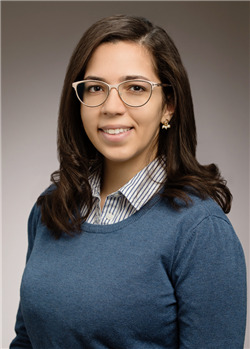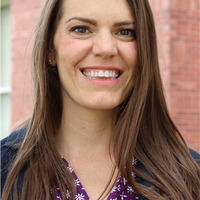May 2023 - Dr. Isabella Condotta
Dr. Isabella Condotta is an agricultural engineer and an Assistant Professor of Animal Sciences at the College of Agricultural, Consumer and Environmental Sciences. Her work seeks to reduce animal stress and improve animal well-being while improving environmental sustainability. She also helps farmers to make more efficient decisions through the development of precision management systems. Her research is interdisciplinary and uses technologies such as machine learning algorithms and image and audio processing to monitor the health, behaviors, and well-being of individual animals.
From the University Archives:
Dr. Condotta is not the first person at the University of Illinois to take a more interdisciplinary and computer based approach to agricultural and animal sciences in order to do innovative work. Dr. Earl R. Swanson was hired in 1952 by the Department of Agriculture Economics to teach farm management. Upon joining the University, Dr. Swanson used the University’s newly built digital computer in order to experiment with linear programming problems. This letter from December of 1953 is one of a number Dr. Swanson sent out as he prepared to write a program for the computer to tackle these linear programming problems.
In this letter sent out by Dr. Swanson to a colleague a few months later, he reports that they had completed their code and were starting to solve simple problems. He also mentions that he was starting to solve livestock ration problems. It was precisely these livestock feed problems that ended up being one of Dr. Swanson’s biggest contributions to the field.
By 1955, Dr. Swanson had been able to introduce the use of linear programming to the animal feed industry “to solve the old problem of cutting costs without lowering product quality” (Swanson, p 40). This article from 1955 was written by Dr. Swanson to introduce his new technique and the ways he thought it could be utilized going forward.
Dr. Swanson’s method gradually got adopted by feed manufacturers until it was the universally used way to calculate and keep down the cost of feed mixes. This article from 1998 talks about how the method gained popularity and mentions that the mathematical technique remained the same as when Dr. Swanson introduced it 43 years earlier. Even today, Dr. Swanson’s method is still in use by feed manufacturers.
One of the people who has worked to illuminate the important work of people like Dr. Swanson was Theresa B. Miller who served as a lecturer and academic adviser in the Department of Agricultural and Consumer Economics from 2001 to 2016. As part of her work for the university, she wrote a book titled A History of Agricultural Economics at Illinois: Scholarship and Service 1932-2007 which was written in celebration of the department’s 75th anniversary in 2007.
As part of her research, Miller conducted interviews with many past faculty members including Dr. Swanson. The notes from her interview with Dr. Swanson in 2006 can be seen here.
While Miller’s book illuminates some of the important work done in the Department of Agriculture in the 20th century, it also highlights how underrepresented women have been in the department. Only one of the faculty she interviewed was a woman and prior to the department merging with consumer economics in 1995, there were only a handful of women faculty in the department. The underrepresentation of women can be seen in this early draft of what eventually became “Appendix C: Faculty Listing 1930-2007” in Millar’s book.
While her research focus is different, Dr. Condotta also utilizes technology in her work. Currently she is part of a grant project funded by USDA’s National Institute of Food and Agriculture to study regenerative farming using technology (Shipman). As part of this project, Dr. Condotta is working to test drones for their potential use in outdoor animal care and is working to design sensors that will continuously monitor animal health (Shipman).
Through her work, Dr. Condotta hopes that her “example can inspire and show young girls that they can work and succeed in anything they put their minds to” in a field that is still largely dominated by men (Condotta).
Sources and Further Reading:
- Condotta, Isabella [@DigitalAgUIUC]. Twitter, March 26, 2021, https://twitter.com/DigitalAgUIUC/status/1375445125128667144
- Earl R. Swanson Papers, 1939-91, Record Series 8/4/26, Box 2, University of Illinois Archives
- Shipman, Kay, “Robots and drones working U of I’s farm of the future,” FarmWeekNow.com, November 21, 2022
- Theresa B. Miller Papers, Record Series 8/1/25, University of Illinois Archives

